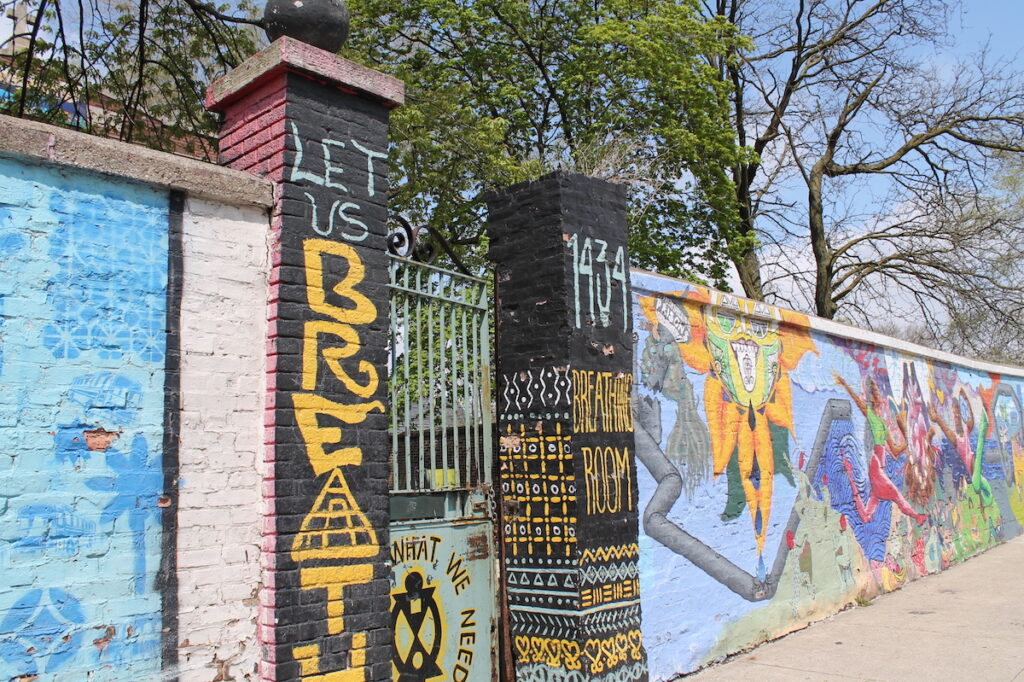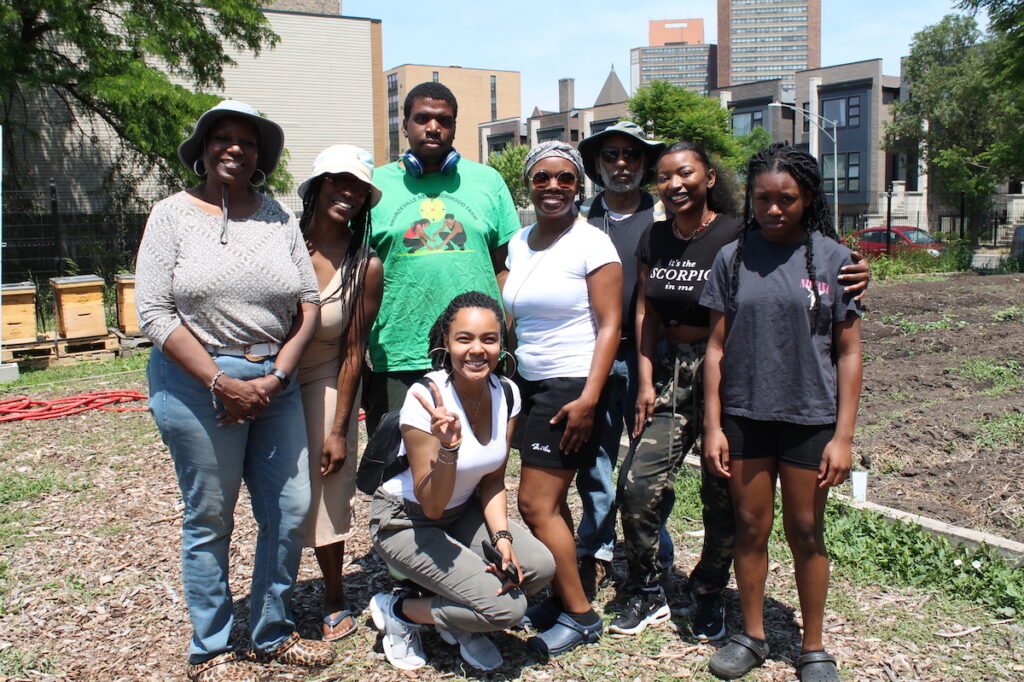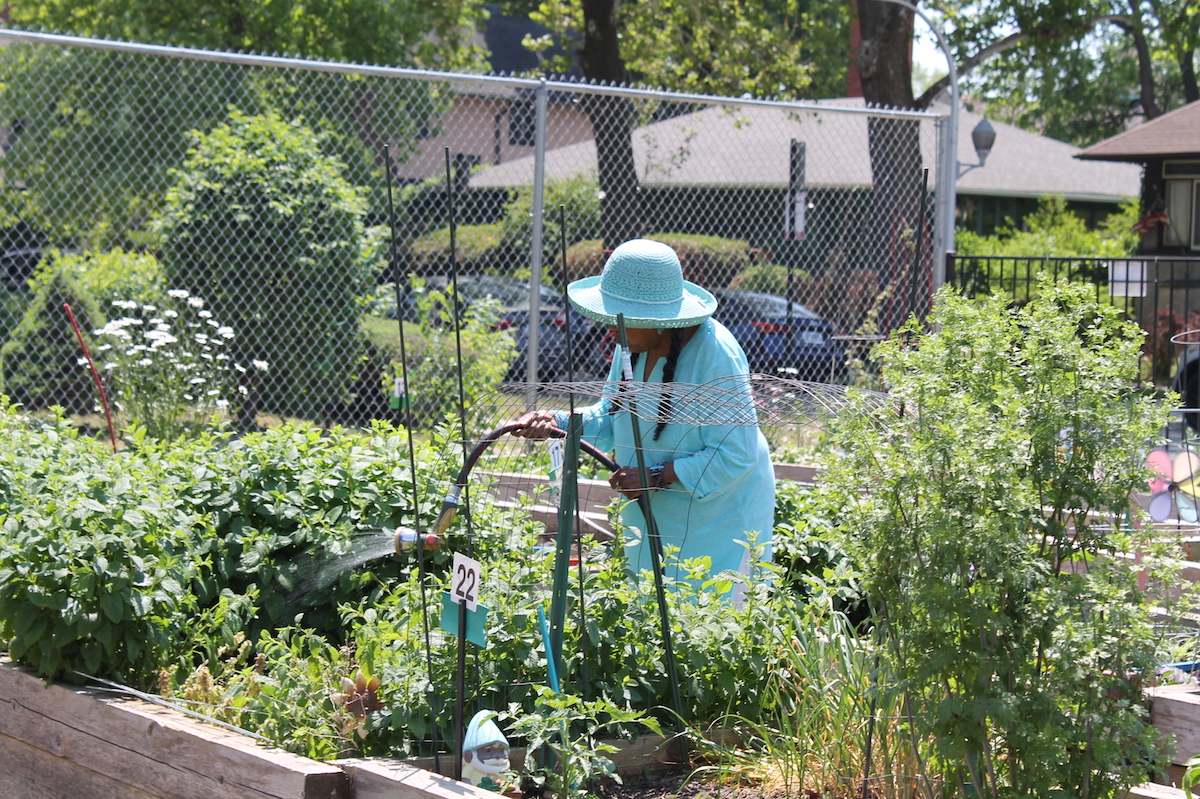On a warm and sunny Saturday in June, the sounds of soul music emanated from the corner of 71st and Crandon Street. With gates wide open, the Crandon Community Garden welcomed in South Shore community members stopping by for its opening weekend. Amidst the garden’s forty-three raised beds and shaded picnic tables, young children explored with curiosity and elders tended to thirsty plants.
On the South Side, these examples of urban agriculture and intergenerational community have become increasingly common.
In 2022 there were around 10,000 vacant city-owned lots in Chicago. Of those, the majority are located in disinvested neighborhoods on the South and West Sides. The empty, sprawling spaces are often eye sores, overrun by trash.
“It was nothing: just three empty lots,” said Crandon garden leader Anita Johnson, describing the desolate corner before its transformation into a community space in the summer of 2016. Johnson recalls that day fondly as the moment she became invested in the garden’s future. When the original 1,200-gallon water tank wasn’t working, she used her shopping cart to transport five-gallon buckets of water from her home a few blocks away just to keep the trees alive. “I grew up in Chicago but I did not have fruit trees when I was growing up,” said Johnson. “So when I saw a cherry tree and a plum tree . . . I couldn’t let those trees stop [growing].”
Like many of the garden members, Johnson is a resident of South Shore. The garden is protected and supported by NeighborSpace, a nonprofit urban land trust in Chicago, and serves as a solution to a growing need within the community for reliable fresh food.
“We have tried to teach people to be self-sustainable. We tell ‘em, you don’t need a backyard to grow something,” said Johnson. That urge toward self-sustainability was a grassroots response to the lack of an accessible grocery store in the South Shore community for over six years, until the opening of a Local Market in 2019.
Within the last year, several major grocery stores have closed down on the South Side: the Whole Foods in Englewood, the Aldi in Auburn Gresham, and the recent Walmart closures impacting the Kenwood and Chatham neighborhoods. These closures continue to reinforce the state of food apartheid in South Side communities, with some residents needing to take two or three buses to the nearest grocery store, resulting in hours-long commutes to gain access to fresh food. But this active, ongoing disinvestment on the South Side has resulted in social and political resistance, including a renaissance of community gardens and farms.

The inequities of the food system were startlingly clear during the harrowing first months of the COVID-19 pandemic. With so many South Siders confined to their homes, and many of them out of work, the urban agriculture community stepped up to address the area’s urgent need for locally grown, free and low-cost food.
Jah Brown, co-founder of Brown People Foundation and program facilitator with #LetUsBreathe Collective’s Breathing Room Gardens, remembers the comprehensive response of these organizations to support food distribution during the early days of the pandemic. “People were isolating and sheltering in place. A lot of seniors didn’t have access to food and people who were reliant on different services weren’t able to get food,” they said.
“So a lot of our initial programming was around doing pop up food distributions,” Brown said. “We’d partner with local pantries and pick up cases and cases of food and set up either in front of a school or a park, or like a parking lot, and just distribute the food to the community.” They also packed bags and took them to nursing homes and senior facilities.
Such emergency response efforts didn’t end in 2020. The Breathing Room Gardens, a project of the #LetUsBreathe Collective located in Back of the Yards, continues to sustain the organization’s #EverybodyEats food justice program, which offers free produce and community meals under the leadership of Chef Kwamena Jackson.
“It’s a desert, but it’s not,” said Brown. They shared how food access is “shifting because of grassroots work and organizations like [Brown People Foundation and #LetUsBreathe Collective] really coming together” under a politics of “sovereignty and self-actualization.”
The looming economic recession facing the country, unreliable food supply chains, and rapidly rising food prices have made growing local food even more appealing for many citizens. Further east in Woodlawn, Quory Watkins, a farmer and urban agriculture educator of over a decade, understands the importance of growing local foods. His work with the Experimental Station and its 61st St Farmers Market, The Urban Canopy and the First Presbyterian Church community gardens provides him with a multifaceted understanding of the state of urban agriculture on the South Side.
We met at the First Presbyterian Church where Watkins leads a free seed starting program for members of the church’s two gardens, Kumunda and 65th & Woodlawn. In our interview, Watkins reflected on how more people in the neighborhood are seeing the value of growing their own food as groceries become more expensive.
While there have always been devoted growers and farmers who, as Watkins said, “are always gonna be there and always gonna come back because they understand the importance of growing their own food in their neighborhood,” a growing number of newcomers are stewarding plots less as a hobby and more as both an essential investment to lower grocery bills and a way to connect with their neighbors.
When describing the First Presbyterian Church community gardens he’s supported the last few years, Watkins observed how many people stay committed to growing there for relational reasons. “You know some of the people that garden next to you. You have a relationship with those people and you know that you can trade [food] throughout the year.”
He believes many people keep returning for “a community vibe—having that community space where everyone feels accepted.” Whether sharing heirloom tomato seeds, exchanging cabbage for kale, or trading the best techniques to keep weeds under control, relational connection influences every part of community gardening.
Harrison Alexander Baker Jr. is one of those individuals. An assistant principal at a local high school, Baker spends his spare time raising his two children alongside his wife and contributing as a community leader at the Kumunda community garden. He identified the garden as a major draw for him and his wife when relocating to a home right next to the growing space. From Baker’s perspective, the community garden became the epicenter of social life and community connection at the height of the pandemic and continues to serve a similar purpose.

At the Bronzeville Neighborhood Farm, the desire to create safe spaces, build relationships, and learn in community honors the intentions of the farm’s late founder, Johnnie L. Owens Jr, who was killed in a home invasion in 2021.
“It’s a legacy,” said Rosalyn Owens, the current farm leader and Owens’s widow. “[In the days surrounding] his funeral, I just said, I’m gonna take over the farm. Did I know what I was signing up for? No . . . [but] the conviction in me is so strong that this has to continue.”
The farm’s white hoop house stands out amongst the single family and three-story homes of Bronzeville. The farming structure allows seeds to start germinating and growing in a protected space before the last frost. This and other resources acquired through grants and community support allowed the garden to thrive for over five years in its current location before Rosalyn Owens took over two years ago.
“There’s more to it than just putting the seeds in the ground,” she said. “You have to be able to draw people to want to come and support you, to volunteer . . . [Johnnie believed] you had to build a relationship. You gotta have face-to-face conversations.” As their website says: “We not only grow crops, we grow community. Bringing people together for the common good.”
With the closing of CPS schools in 2013 and the dwindling number of reliable after school programs, the Bronzeville Neighborhood Farm serves as what Tyia Morgan, the farm’s digital communications manager, described as a “third space” to support youth in the unaccounted for time between the structure of school and home life. “If you drive around . . . a lot of the times you don’t see kids playing at parks anymore. . . .You gotta have spaces like [the farm] that are monitored, that are gated, that are supervised.”
The farm currently works closely with students from Leo High School in the Auburn-Gresham neighborhood, and offers volunteer opportunities for students to meet their community service hours. While Owens described the opportunity for young people to work on an urban farm as a chance for them to develop a stronger work ethic and sense of social responsibility, she also acknowledged that the growth and learning goes both ways.
“I like being around young people, you know, cuz you can learn. I’m sure I teach them something, but I like learning from them too,” said Owens. The intergenerational relationships the farm cultivates help instill values of care, collaboration, and trust in communities that have been heavily impacted by violence and separation.
Beyond the immediate benefits of food access, socialization, and youth engagement, many people identify a deeper ancestral or even spiritual connection occuring in the process of growing their own food.
“When I first stepped into the garden and I started planting there was like internal knowledge that I didn’t know that I had,” Harrison Baker said. “My father’s from South Carolina, my mom’s from Virginia. . . . I see that I come from a long line of farmers. There is something ancestral . . . innate about it.”
For Rosalyn Owens, a beautiful photo wall of famous South Side Chicagoans and community organizers, including her beloved late husband, serves as a reminder of the people that continue to inspire the work of the Bronzeville Neighborhood Farm.
At the Breathing Room Gardens, ancestral veneration and connection is also central to the growing experience. There’s an altar in the Breathing Room community center and the gardens to intentionally create, as Jah Brown said, “a space where people can honor those that came before them.” Images of deceased relatives, community icons, and leaders as well as incense and offerings grace these places of remembrance.
With a growing number of Black folks and other people of color embracing farming and gardening, many of these spaces have become sites of healing through land stewardship and ancestral reconnection. In their simplest sense, community gardens and farms on the South Side serve as spaces to reactivate and reintroduce core human values and practices. As common community resources and social services become less reliable in the wake of the COVID-19 pandemic, the call toward hyperlocal community care continues to gain power.
“I would love to see the garden just full of people all day, every day during the summertime,” said Anita Johnson. “I tell people all the time, you don’t have to work just because you come in here!” As the first day of the Crandon Community Garden’s opening weekend comes to a close, the lingering laughter of garden members shows that the message has been received.
As the South Side continues to heal and recover from the effects of the COVID-19 pandemic and the challenges it has exacerbated, community gardens and farms serve as beacons of hope for a different way to relate and connect. Looking out over the Crandon Community Garden at the smiling faces engaged in conversation, it’s clear that more than plants are being nurtured.
“I’m looking forward to seeing some rejuvenation over here,” said Johnson, in reference to her South Shore community of over two decades. “Hopefully the garden can be a part of that.”
For more information about joining your local community garden or how to support urban farms this summer, visit the Chicago Urban Agriculture Mapping Project’s website.
Jasmine is a writer and space maker based in Woodlawn with a deep commitment to relational healing and creative self expression. As a self-identified “disciple of joy,” she brings a deep curiosity to all aspects of her life.




I thought this article was insightful, thought provoking for the future and really connected with the current situation in the country and in the world
Yes, this article was very uplifting. It’s great to know that the youth have a place to go, work, and enjoy as an after-school recreation!! I applaud you all and Especially Mrs Rosalyn Owens for continuing the program after the tragic loss of her dear husband ❤️🙏
I want to applaud and congratulate Mrs. Rosalyn Owens for her commitment to keeping her husband and renown community organizer, Johnnie L. Owens Jr., dream alive; the Bronzeville Neighborhood Farm, while nurturing, growing and even expanding this concept to other Chicago area neighborhoods. Thank you Johnnie L. Owens Jr. for your contributions and commitments as you will be greatly remembered and missed.
Thank you Jasmine Barnes for writing such an eloquent article highlighting these Chicagoans who have dedicated their time and talents to keeping hopes and dreams alive while providing useful and creative tools for survival and sustainability. This is a beautifully well written and informative article highlighting issues that many inner city community residents are experiencing these days. It is very refreshing to read about the commitments made by Chicago residents to restore and pass on intergenerational skills and knowledge of our past, even for former Chicagoans who no longer reside in “Chi Town”.
KEEP HOPE ALIVE!